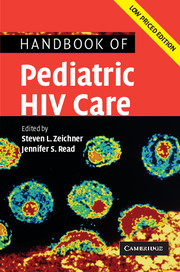Book contents
- Frontmatter
- Contents
- List of contributors
- List of abbreviations
- Foreword
- Preface
- Part I Scientific basis of pediatric HIV care
- Part II General issues in the care of pediatric HIV patients
- Part III Antiretroviral therapy
- 11 Antiretroviral therapy
- 12 Antiretroviral drug interactions
- 13 Metabolic complications of antiretroviral therapy in children
- 14 HIV drug resistance
- 15 Initiating and changing antiretroviral therapy
- 16 Therapeutic drug monitoring
- 17 HIV postexposure prophylaxis for pediatric patients
- Part IV Clinical manifestations of HIV infection in children
- Part V Infectious problems in pediatric HIV disease
- Part VI Medical, social, and legal issues
- Appendix 1 Formulary of antiretroviral agents
- Appendix 2 National Institutes of Health sponsored clinical trials for pediatric HIV disease
- Appendix 3 Selected HIV-related internet resources
- Appendix 4 Selected legal resources for HIV-infected children
- Index
- References
11 - Antiretroviral therapy
Published online by Cambridge University Press: 23 December 2009
- Frontmatter
- Contents
- List of contributors
- List of abbreviations
- Foreword
- Preface
- Part I Scientific basis of pediatric HIV care
- Part II General issues in the care of pediatric HIV patients
- Part III Antiretroviral therapy
- 11 Antiretroviral therapy
- 12 Antiretroviral drug interactions
- 13 Metabolic complications of antiretroviral therapy in children
- 14 HIV drug resistance
- 15 Initiating and changing antiretroviral therapy
- 16 Therapeutic drug monitoring
- 17 HIV postexposure prophylaxis for pediatric patients
- Part IV Clinical manifestations of HIV infection in children
- Part V Infectious problems in pediatric HIV disease
- Part VI Medical, social, and legal issues
- Appendix 1 Formulary of antiretroviral agents
- Appendix 2 National Institutes of Health sponsored clinical trials for pediatric HIV disease
- Appendix 3 Selected HIV-related internet resources
- Appendix 4 Selected legal resources for HIV-infected children
- Index
- References
Summary
The biology of HIV and antiretroviral therapy
Chapter 1 describes the HIV life cycle and outlines the steps in the life cycle targeted by antiretroviral drugs. The viral targets of antiretroviral agents are outlined in Chapter 1 Fig. 1.3, and Table 1.6. The antiretroviral drugs in current clinical use inhibit either the viral reverse transcriptase, the viral protease, or block the fusion of the virus with the membrane of its would-be future host cell. Additional viral targets (e.g., the viral integrase or chemokine receptors) are the subject of drug development efforts, but there are no currently approved antiviral drugs directed at these other targets
There are two classes of reverse transcriptase inhibitors (RTIs), the nucleoside analogue RTIs (NRTIs) and the non-nucleoside RTIs (NNRTIs). Nucleoside-analogue reverse transcriptase inhibitors (NRTIs) are modified nucleosides that are designed to lack a 3′OH group (see Chapter 1, Fig. 1.4). (Tenofovir is a nucleotide analagon, see below.) They are phosphorylated by host cell kinases and then incorporated into the elongating polynucleotide chain. Their incorporation produces a prematurely terminated cDNA molecule because another nucleotide cannot add to the chain due to the absent 3′OH. The viral reverse transcriptase has a greater relative affinity for the modified nucleosides than does the human DNA polymerase, which is why nucleoside analogues have a tolerable therapeutic index. The non-nucleoside RT inhibitors, NNRTIs, act through a different mechanism than the NRTIs. The NNRTIs interfere with binding at the active site of the reverse transcriptase.
- Type
- Chapter
- Information
- Handbook of Pediatric HIV Care , pp. 335 - 359Publisher: Cambridge University PressPrint publication year: 2006

